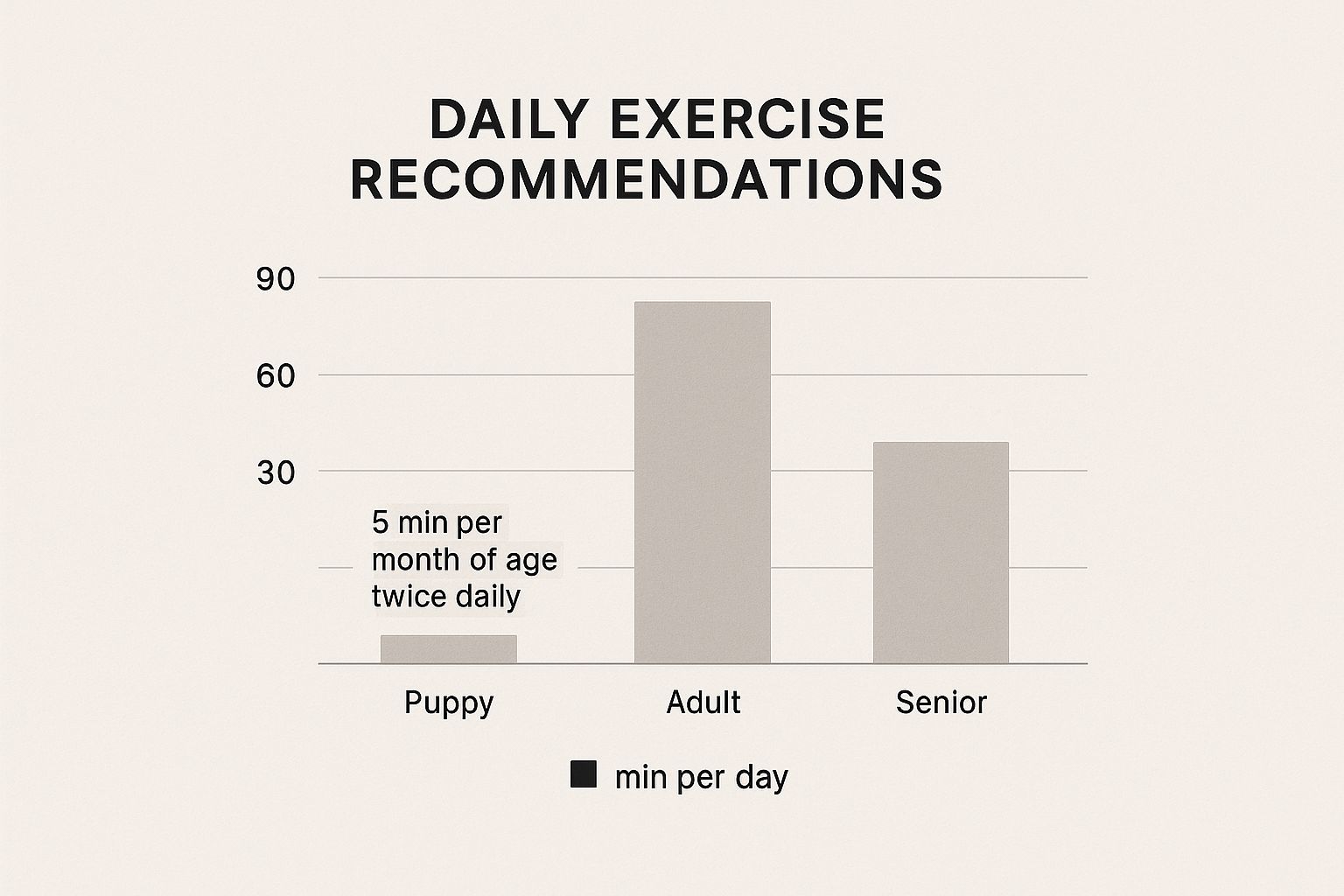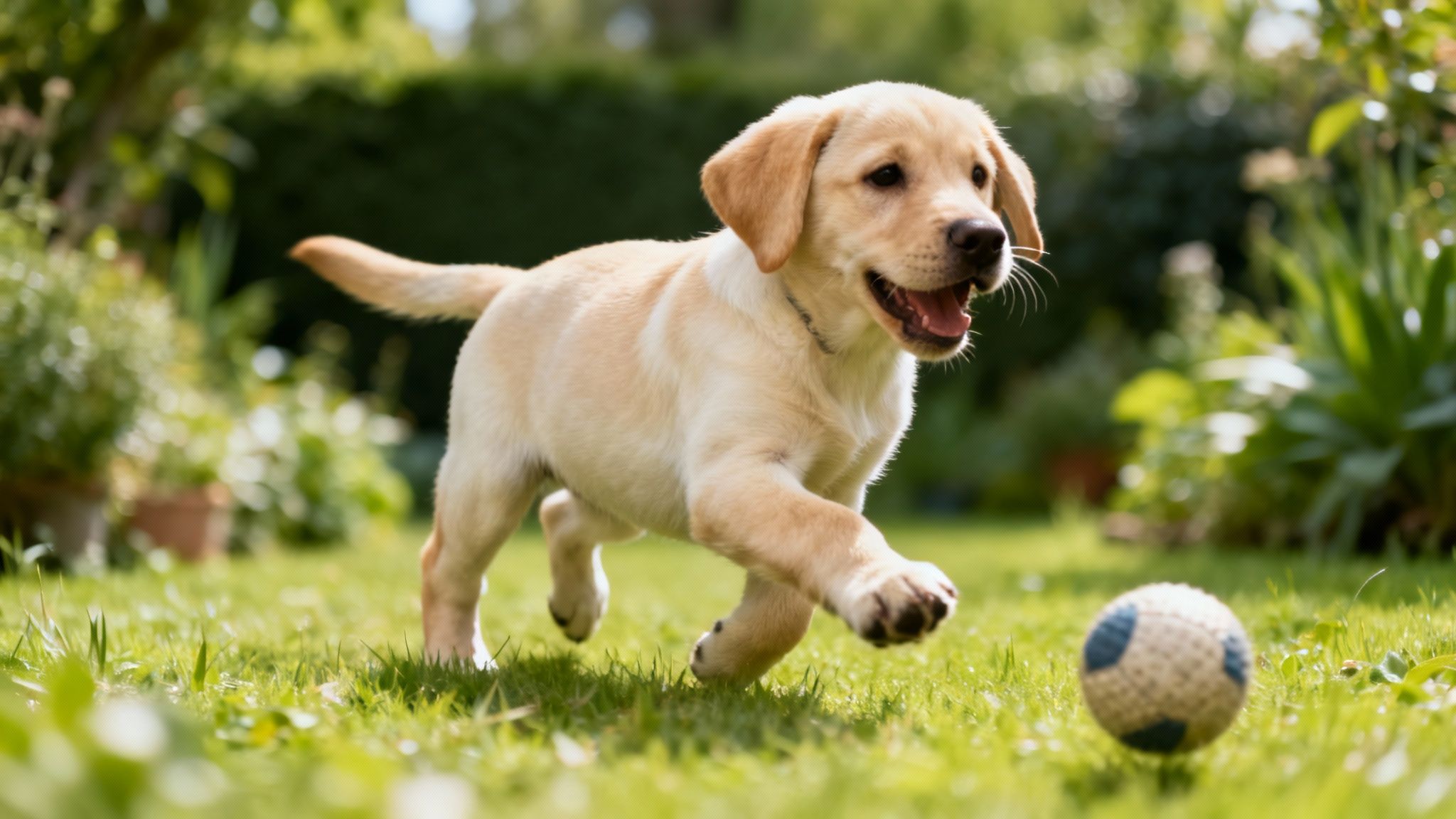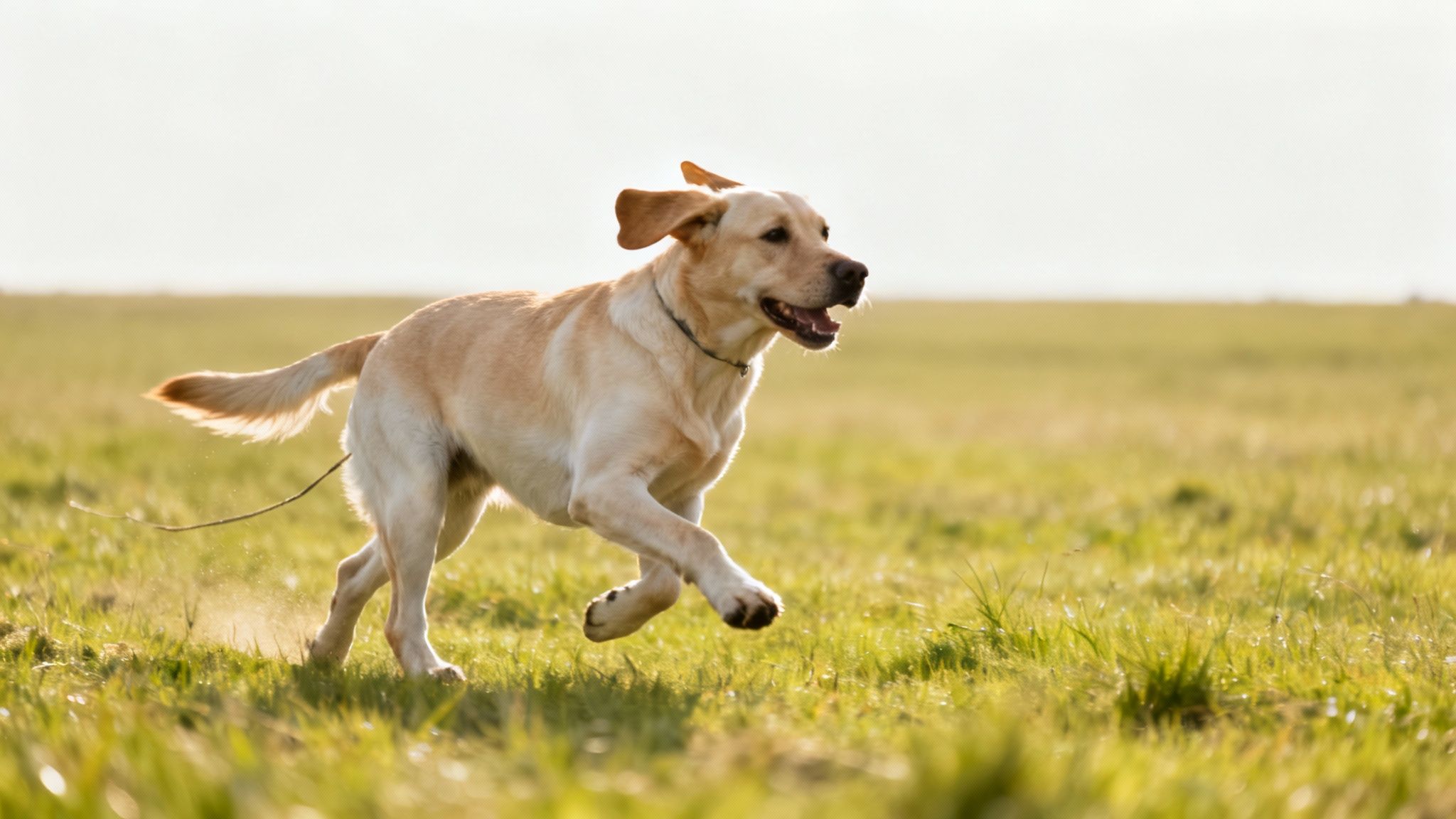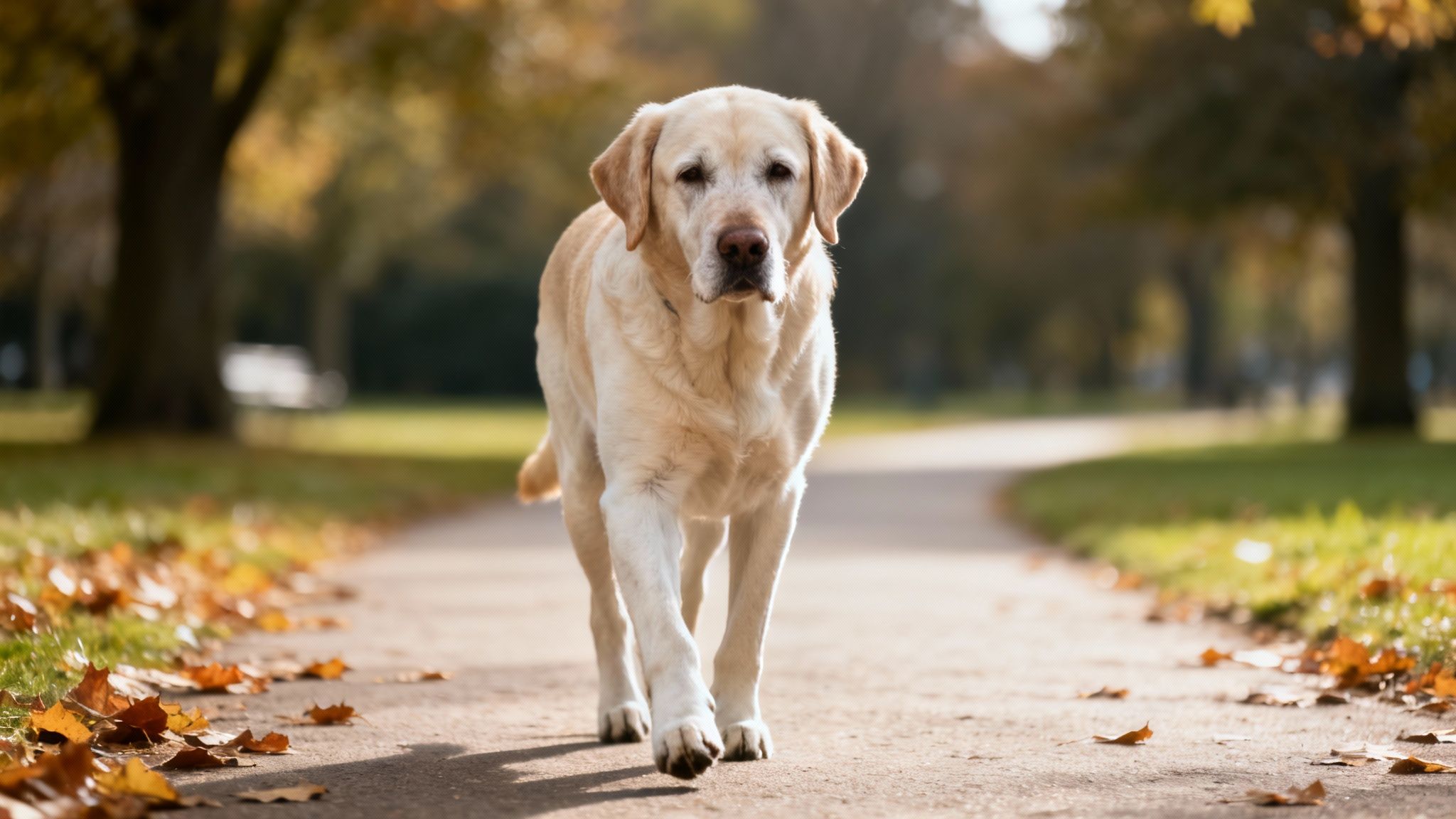As a loving Lab owner, you know your furry friend needs plenty of activity. But how much is just right? For a healthy, adult Labrador, we're looking at around 60-90 minutes of stimulating exercise every single day. Now, this doesn't just mean a long, boring plod around the block. It’s all about mixing up activities that keep them physically fit and, just as importantly, mentally engaged. We have to tap into those wonderful natural retriever instincts!
Your Labrador's Daily Exercise Needs Explained
You're here because you love your Labrador and want to give them the best, happiest life possible. We completely get it. But figuring out exactly how much exercise they need can feel like a puzzle, especially when their energy seems absolutely boundless!
It’s all about channelling their natural enthusiasm into things that work both their body and their brain. Think of it as a daily investment in their well-being, and frankly, our own peace of mind. A well-exercised Lab is far less likely to get bored, which means they're much more likely to be a calm, contented companion at home. This isn't just about preventing chewed furniture; it's about fulfilling their deep-seated need to move, work, and think.
For a healthy adult, this usually means at least an hour of dedicated activity each day. This isn't just a random number; it's a guideline widely supported by UK pet care experts who know it’s crucial for preventing behavioural issues that can stem from pent-up energy.
To help you get a clearer picture, we've put together a quick-glance guide breaking down what your Labrador needs at different stages of their life.
Labrador Daily Exercise Guide at a Glance
This table offers a simple summary to help you tailor your dog's routine as they grow with you.
| Life Stage | Recommended Daily Exercise | Key Considerations |
|---|---|---|
| Puppy (Under 1 year) | 5 mins per month of age, twice daily | Short, gentle sessions. We must protect growing joints. Focus on socialisation and basic training. |
| Adult (1-7 years) | 60-90+ minutes | Mix of walks, runs, swimming, and fetch. Prioritise mental stimulation and training together. |
| Senior (7+ years) | 30-60 minutes | Moderate, low-impact exercise like walking or swimming. Watch them for signs of discomfort. |
Remember, these are just guidelines. You know your dog best, so always watch for signs of tiredness or over-excitement and adjust your routine accordingly.
As you can see, the requirements change quite a bit as your dog grows, from short, playful bursts for puppies to more moderate sessions for our seniors. Understanding these breed-specific traits is absolutely vital. You can learn more about the energetic and joyful nature of the Labrador Retriever in our complete guide.
Exercising Your Labrador Puppy the Right Way
That adorable bundle of energy tearing around your home needs very careful handling. While it’s incredibly tempting to want to wear them out, a young Labrador’s growing body is surprisingly vulnerable. We understand that worry. Their bones and joints are still developing, and putting too much strain on them now can cause real problems down the line.
This is where the famous ‘five-minute rule’ comes in. It’s a trusted guideline from vets and breeders right across the UK and offers a simple, safe way to make sure your pup gets just the right amount of activity without overdoing it.
Understanding the Five-Minute Rule
So, what exactly is this rule? It’s a straightforward formula designed to protect your puppy’s developing joints from long-term damage, giving you peace of mind.
The guideline suggests providing five minutes of structured exercise per month of your puppy's age, up to twice a day. So, your three-month-old Labrador puppy would need about 15 minutes of structured exercise, twice daily.
When we say 'structured exercise', we're talking about things like lead walks, not just a free-for-all play in the garden. It’s a concept that applies to many breeds, and you can learn more by reading our general guide on how much exercise a puppy needs to be healthy.
This gentle approach ensures they build strength gradually. More importantly, it encourages gentle garden play, very short lead walks for crucial socialisation, and using puzzle toys to engage their busy minds.
Safe Activities vs Activities to Avoid
Knowing what to do is just as important as knowing what not to do. Your goal is to build a strong, healthy foundation for a lifetime of adventure together.
Here are some examples of what to focus on and what to steer clear of:
- Do encourage: Gentle play sessions, short sniffing walks on soft surfaces like grass, and basic training games. These activities build confidence and mental skills without physical strain.
- Do not allow: Repetitive jumping (like catching a frisbee), running on hard pavements, or long, strenuous runs. These high-impact activities put far too much pressure on their soft growth plates.
Keeping Your Adult Labrador Thriving
Once your Labrador hits their adult prime, usually somewhere between one and two years old, you get to see what they’re really made of. Their true athletic potential starts to bubble to the surface. Gone are the days of carefully counting minutes on a walk; now, the real fun can begin.
This is the perfect time to build a rich and varied exercise routine that properly satisfies their energetic nature. Let's forget just sticking to the same old lead walks. To keep an adult Lab truly happy, we need to think about their daily activity as a mix of different movements that challenge their body and, just as importantly, their brain.
A brilliant starting point is balancing disciplined on-lead walks with the sheer, unadulterated joy of an off-lead tear-around in a secure field. The controlled walk sharpens up their manners and focus, while the free run lets them stretch their legs and just be a dog. It's this combination that helps us build a happy, well-behaved companion.
Tapping Into Their Natural Instincts
If you really want to tire out a Labrador, you have to engage that clever mind of theirs. A one-hour walk might tire their legs, but it won't do much to satisfy their brain. Remember, these dogs were bred for a job, and giving them an outlet for those instincts is one of the most rewarding things you can do for them.
It seems many UK Labrador owners have already figured this out. Detailed lifestyle research discovered that the average daily exercise for Labradors was around 129 minutes—way more than the minimum guidelines suggest. This figure often included a mix of activities like off-lead running and fetch, showing how we instinctively meet our dogs' needs for varied stimulation. You can read more about it in the UK Labrador lifestyle research.
By working with their natural strengths, you make exercise more engaging for both of you.
A physically tired dog will rest, but a mentally fulfilled dog will be content. The goal is to provide activities that challenge their natural abilities, strengthening your bond and preventing the boredom that often leads to unwanted behaviours at home.
Building a Balanced Weekly Plan
So, what does this actually look like day-to-day? Instead of trudging the same route every single day, try mixing things up with activities that play to their retriever heritage.
- Swimming: Let's be honest, most Labradors are more fish than dog. A swim in a local lake or at a dog-friendly beach is a fantastic, low-impact workout that exercises their entire body.
- Scent Work: This is a brilliant brain game. Hide some treats or a favourite toy around the garden and let that powerful nose do the work. It’s mentally exhausting for them in the best possible way.
- Retrieval Games: You can't go wrong with a classic game of fetch. It does more than just burn off energy; it taps right into that deep-seated instinct to retrieve something and bring it back to you.
Adapting Exercise for Your Senior Labrador
As your loyal friend enters their golden years, usually around the age of seven or eight, you’ll start to notice their pace soften. It's a natural part of their journey with us. But just because they're slowing down doesn't mean it’s time to hang up the lead. In fact, consistent, gentle exercise becomes more important than ever.
It’s our job to help them age gracefully, and a thoughtful routine is the best tool we have. The focus switches from high-energy bursts to simply maintaining their quality of life. Regular movement helps preserve muscle tone, keeps their joints mobile, and holds their weight in a healthy range – all crucial for an older dog.
So, what's the magic number? For most senior Labradors, aiming for around 30-60 minutes of low-impact activity each day is a brilliant target.
Making Thoughtful Adjustments
This is all about swapping intensity for consistency. Those long, strenuous hikes you both once loved might need to become shorter, more frequent strolls. This approach still lets them enjoy all their favourite sniffing spots without over-exerting themselves.
Think of it as trading a marathon for a series of pleasant walks. You're keeping them engaged and active without putting unnecessary strain on their ageing body.
The goal isn't to tire them out, but to keep them moving comfortably. Listening to their body is the most important part of exercising your senior companion. Shorter, gentler sessions are far better than pushing them too hard.
Low-Impact Activities Are Your Friend
Protecting their joints is now our number one priority. High-impact stuff, like franticly leaping for a ball, should be phased out in favour of gentler options that are kinder on their body.
Here are some brilliant, joint-friendly activities for your older Lab:
- Gentle Walks: Instead of one long trek, try two or three shorter 15-20 minute walks. If you can, stick to soft surfaces like grass, which are much kinder on their joints than hard pavement.
- Swimming: This is pretty much the perfect workout for a senior dog. The water supports their weight, letting them build muscle and boost their heart health with absolutely zero impact on their joints.
- Scent Games: Hiding treats around the garden or the house is a fantastic way to give them some much-needed mental stimulation without any physical strain.
Above all, watch them closely. Learning to read the subtle cues that signal they're getting tired or feeling a bit sore allows you to adapt on the fly. This way, you can make sure exercise always remains a positive and comfortable experience for your old friend.
More Than Just a Walk: Why Mental Stimulation Matters
We've all heard the old saying, "a tired dog is a good dog," and there's definitely some truth to it. But we've found that a mentally fulfilled Labrador is a truly happy one. Physical exercise is just one piece of the puzzle. These are incredibly intelligent dogs, bred to think and work alongside people for generations. Their brains need a workout just as much as their bodies do.
Providing mental challenges is your secret weapon against the kind of mischief that springs from boredom. When a Lab doesn't have a ‘job’ to do, they’ll often invent one for themselves—and you might not like their choice! Engaging their mind is a powerful way to channel all that famous Labrador energy constructively.
Fun Ways to Challenge Their Brain
So, how can you bring this mental enrichment into your daily routine? It's much easier and more fun than you might think. You don't need a load of expensive equipment; you just need to get a little creative and tap into their natural instincts.
- Puzzle Feeders: Try swapping their normal food bowl for a puzzle feeder. This turns mealtime into an engaging challenge, making them work for their food and satisfying that deep-seated need to problem-solve.
- 'Find the Treat' Games: This is such a simple scent game, but it's brilliant. Just hide some of their favourite high-value treats around a room or the garden and encourage them to "find it!" It's a fantastic way to tire them out, especially on a rainy day.
- Dog Sports: Getting involved in activities like agility or obedience classes provides a brilliant physical and mental workout all in one. These sports tap into your Lab's innate desire to learn, please you, and work together as a team.
Research from a UK-based veterinary study highlighted that breeds like Labradors often need more than two hours of exercise daily, which really underscores their need for both physical and mental outlets to thrive. You can find out more by exploring the findings on breed-specific exercise needs.
By adding brain games into the mix, you’re not just burning off energy; you’re building a deeper bond and nurturing a well-balanced, happy companion. If you're worried your dog isn't getting enough stimulation, it's worth checking out these common signs your dog is bored.
Got a Question About Your Lab's Exercise?
Even after covering the basics, it's completely normal to have a few specific questions buzzing around your head. Every Labrador is an individual, after all, and you want to get things just right for your best friend.
To help you feel more confident, we've pulled together some of the most common queries we hear from fellow Labrador owners across the UK. Here are some straight-talking, practical answers to help you fine-tune your routine.
Can I Over-Exercise My Labrador?
Yes, you absolutely can, and it's something we all need to be mindful of. This is especially true for your puppy. Their soft growth plates are still developing and can be easily damaged by too much high-impact activity.
For adult Labs, it’s less about a strict time limit and more about learning to read their body language. Keep an eye out for signs like lagging behind on a walk, excessive panting long after you’ve stopped, or obvious stiffness and reluctance to get up after a big day out. It’s always better to build up intensity gradually and make sure they have proper rest days to recover, just like any athlete.
What Are the Signs My Lab Needs More Exercise?
A bored Labrador will often invent their own "job," and you might not be a fan of their career choice! If you're wondering how much exercise Labradors need to stay out of trouble, their behaviour will usually give you the clues.
Common signs of pent-up energy include:
- Destructive behaviour: Chewing the furniture, digging up your prized petunias, or shredding the post are classic signs.
- Hyperactivity indoors: Are they constantly restless, unable to settle, or pestering you for attention?
- Sudden weight gain: If their diet hasn't changed, a lack of activity could well be the culprit.
These are often your dog's way of telling you, "I need a better way to burn off this energy!"
A small increase in daily activity—even just adding a 15-minute game of fetch or a puzzle toy—can make a world of difference to a Labrador’s behaviour and overall happiness.
How Should We Exercise an Overweight Labrador?
If your companion is carrying a few extra pounds, protecting their joints becomes our absolute top priority. The very first step should always be a chat with your vet to come up with a sensible diet and exercise plan together.
Focus on low-impact activities that get them moving without putting extra strain on their body. Gentle lead walks and swimming are perfect for this. Start with shorter sessions and slowly increase the duration as their fitness improves. It's crucial to steer clear of high-impact stuff like running and jumping until they're at a healthier weight.
Here at K9 Time, we know that life can get hectic. If you need a trusted hand to make sure your Labrador gets the safe, stimulating, and personalised exercise they deserve, we’re here to help. Find out more about our dedicated one-to-one dog walking services at https://k9time.co.uk.





